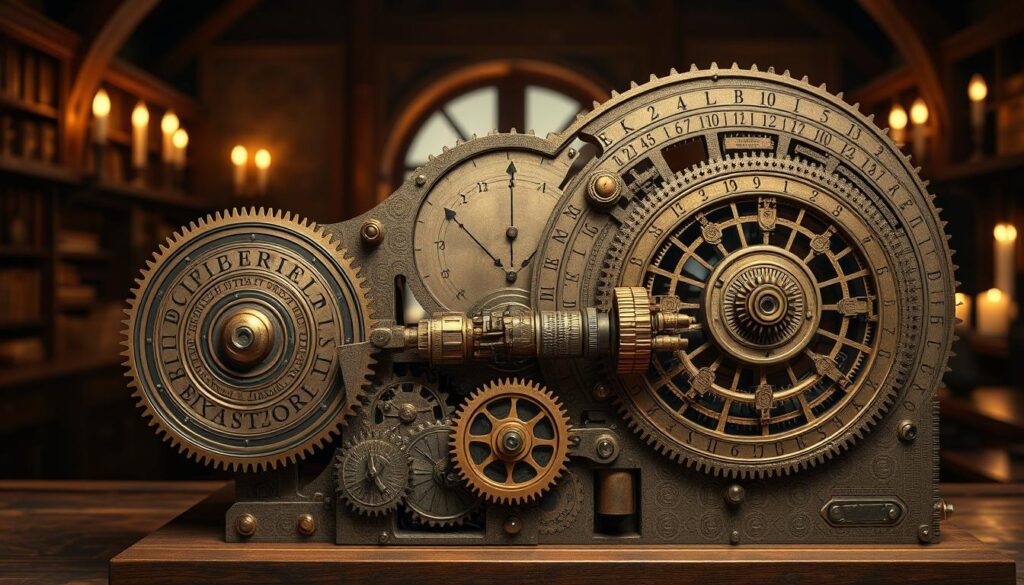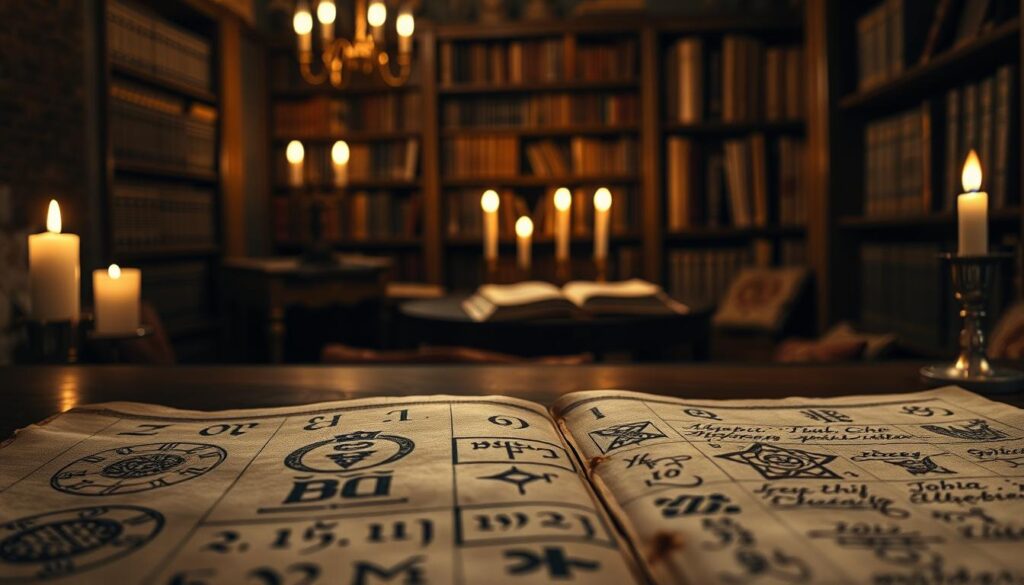Did you know that around 50% of all historical manuscripts contain encrypted text? These ancient secrets give us a peek into the world of codebreaking. The Leonardo Cipher is a standout example of Leonardo da Vinci’s use of cryptography to protect his ideas.
Exploring the Leonardo Cipher, we’ll see its importance in historical cryptography. We’ll also learn about Leonardo da Vinci’s genius. This encryption method shows the depth of his intellect and connects the past to today’s cryptography. Let’s uncover the mysteries of this ancient code and its lasting impact.
Key Takeaways
- The Leonardo Cipher showcases Leonardo da Vinci’s cryptographic brilliance.
- About 50% of historical manuscripts include encrypted text.
- The cipher connects historical practices with modern codebreaking techniques.
- Understanding the cipher offers insights into Da Vinci’s innovative mind.
- We will explore its relevance in today’s world of cryptography.
Introduction to the Leonardo Cipher

The Leonardo Cipher is a blend of art and cryptography. It fascinates those who love encryption systems. To grasp what the Leonardo Cipher is, we need to look at its special traits. It uses symbols and structures made by Leonardo da Vinci, showing his genius in art and intellect.
What is the Leonardo Cipher?
The Leonardo Cipher mixes numbers and letters for secret messages. It’s an early way to hide messages, showing how to keep info safe from others. People like da Vinci worked on these systems, creating complex designs and methods.
The Historical Context of Cryptography
The Leonardo Cipher’s importance comes from its place in cryptography’s history. Over time, encryption systems have grown more complex. Da Vinci’s work fits into this trend, showing the Renaissance’s artistic and intellectual spirit. The Leonardo Cipher is a key part of this history, mixing secrecy and revelation.
Unlocking the Mysteries: How the Leonardo Cipher Works

The world of codemaking is full of secrets. It relies on a few key principles. These principles help us understand how the Leonardo cipher works.
Basic Principles of Codemaking
At the core of codemaking are some fundamental principles. These principles make any cipher effective. One key principle is letter substitution, where each letter is replaced by another.
This method keeps the message’s meaning but changes its appearance. Another method, transposition, rearranges letters or groups. This makes the message even harder to decipher.
Understanding Cipher Techniques
The Leonardo cipher uses various techniques to keep messages safe. It combines substitution and transposition methods. These techniques make it a complex tool for communication.
By studying these techniques, we learn how the Leonardo cipher works. It shows the art and science of codemaking. This reveals the intricate nature of the cipher.
The Life of Leonardo da Vinci and His Connection to the Cipher
Leonardo da Vinci’s life shows us a man of great curiosity and talent. He was not just an artist but also a scientist. His work in both fields might have helped create new ways to send secret messages.
In the context of the da vinci code, we see how he influenced cryptography. His methods and ideas were ahead of his time.
Leonardo’s Influence on Cryptography
Leonardo’s scientific work laid the groundwork for understanding cryptography in the Renaissance. His notebooks are full of observations and new ideas. They show his willingness to uncover hidden meanings in his art.
His life’s work shows the importance of keeping messages safe. This is a key part of cryptography.
Contextualizing the Cipher in Da Vinci’s Work
Leonardo’s art often explores the depths of human emotions and thoughts. This matches the complexity of the Leonardo Cipher. By looking at his symbols, we see the genius of his work.
His art and science blend in a way that’s still inspiring today. It shows how he pushed boundaries in both fields.
Key Features of the Leonardo Cipher

In our exploration of the Leonardo Cipher, we find many unique features. These features make it stand out in cryptography. We look at the symbols and patterns that make it special. This helps us understand its complexity and how it compares to other encryption methods.
Unique Symbols and Patterns
The Leonardo Cipher uses special symbols with their own meanings. These symbols create complex patterns that add to the cipher’s security. They also show Leonardo’s creative side.
These patterns are not just for security. They also make the cipher beautiful. This shows how Leonardo combined art and function in his work.
Comparative Analysis with Other Historical Ciphers
When we compare the Leonardo Cipher to others, we see its unique approach. Unlike the Caesar and Vigenère ciphers, it balances simplicity with art. This makes it special and shows Leonardo’s innovative thinking.
Decoding Techniques for the Leonardo Cipher

Diving into the Leonardo Cipher’s world is exciting. It teaches us key decoding techniques. With these, we can unlock this ancient secret and improve our cipher-solving skills. This part offers a step-by-step guide to decoding and introduces tools for analysis to deepen our understanding.
Step-by-Step Guide to Decoding
To crack the Leonardo Cipher, follow these steps:
- Familiarize Yourself: Start by learning the unique symbols and patterns of the Leonardo Cipher.
- Identify Common Elements: Look for often used letters or symbols to spot words or phrases.
- Record Findings: Note down your discoveries and any clues in a notebook or digital tool.
- Test Assumptions: Try out your guesses in the original text to see if they make sense.
- Iterate the Process: Go back to earlier steps and refine your method as you learn more.
Tools for Cipher Analysis
Several tools can help us decode the Leonardo Cipher better.
- Software Solutions: Tools like Cryptogram Solver and CryptoCrack help with automated deciphering.
- Online Resources: Cryptography websites offer forums and articles to guide us through tough concepts.
- Graphical Analysis Tools: These tools help spot patterns in cipher texts more clearly.
The Significance of the Leonardo Cipher in Modern Cryptography
The Leonardo Cipher is important in modern cryptography. It teaches us about encryption, showing us lessons learned that help today. By looking at Leonardo’s methods, we see their lasting value.
Lessons Learned from Historical Ciphers
Learning from ciphers like the Leonardo Cipher shows us new ways to keep information safe. Each cipher gives us clues about old encryption methods. We learn about making messages complex and using symbols to boost security.
Applications of Leonardo’s Techniques Today
Leonardo’s ideas are used in many parts of modern cryptography. For example, his work helps create better encryption, digital signatures, and secure ways to talk online. These uses prove his ideas are still useful today and can adapt to new tech.
Real-World Examples of the Leonardo Cipher
The Leonardo Cipher has captured the interest of many. It has led to several real-world examples that show its importance in codebreaking. These examples reveal interesting stories and connect history to modern cryptography.
Famous Cases in Codebreaking
History is full of codebreaking cases that use the Leonardo Cipher’s principles. For instance, during World War II, experts used similar methods to decode messages. This shows how the Leonardo Cipher has influenced cryptography for a long time.
Current Research and Discoveries
Today, researchers are still inspired by the Leonardo Cipher. They are finding new ways to decode old messages. Scholars are studying ancient texts to uncover hidden meanings. This work proves that historical ciphers are still vital in today’s cryptography.
Exploring Hidden Messages within the Leonardo Cipher
As we explore Leonardo da Vinci’s world, we find hidden messages in his art. These secrets make us wonder what’s hidden in his masterpieces. Da Vinci’s art is full of symbols and codes, hinting at secrets yet to be found.
Uncovering Mysteries in Da Vinci’s Art
Leonardo’s paintings, like The Last Supper and Mona Lisa, are famous for their beauty and mystery. Each brushstroke might hold a secret. Many think hidden messages are hidden in the colors and the way figures are placed.
These details might reveal deeper meanings tied to the Leonardo Cipher. It makes us look at these famous paintings in a new way.
Influences on Modern Codebreaking Challenges
Today’s cryptographers are inspired by da Vinci’s hidden messages in his art. The challenges of codebreaking today are similar to uncovering these secrets. Da Vinci’s art shows that secrets can last for centuries.
Modern codebreakers see connections between old and new encryption methods. They find the mystery and depth in uncovering hidden truths fascinating.
Tips for Aspiring Cryptographers
For those interested in cryptography, starting with the basics is key. It takes practice and a love for learning to master cipher skills. We’ve gathered tips and resources to help you on your cryptographic path.
Enhancing Your Cipher Skills
Improving cipher skills can be done by solving puzzles and challenges. Websites and forums offer these regularly. They help sharpen our analytical and problem-solving skills.
- Engage with cryptography communities online to share insights and solutions.
- Experiment with different cipher types to discover what resonates with us.
- Keep a journal of codes we decode or create, noting the strategies used.
Resources for Further Learning in Cryptography
There are many resources for those eager to learn more about cryptography. Books, online courses, and websites are great places to start. They help anyone looking to improve their skills in this field.
| Resource Type | Name | Description |
|---|---|---|
| Book | The Code Book | A comprehensive introduction to the history and mechanics of codes and ciphers. |
| Online Course | Cryptography I (Coursera) | A foundational course from Stanford University covering essential cryptographic concepts. |
| Website | CryptoPals | A series of engaging cryptographic challenges designed to teach through hands-on experience. |
Using these resources, aspiring cryptographers can deepen their knowledge. Learning at your own pace is crucial for growth in this field.
Conclusion
We’ve finished our look at the Leonardo Cipher, exploring its unique traits, historical importance, and lasting effect on cryptography. This cipher shows Leonardo da Vinci’s genius and links old and new coding methods. We’ve covered the cipher’s basics and its role in the evolution of cryptography.
The Leonardo Cipher is a symbol of creativity and curiosity in both art and science. It challenges us to keep exploring cryptography’s mysteries. We suggest looking for more hidden messages in Da Vinci’s work and elsewhere, sparking future discoveries.
The secrets in this cipher tell a story about human creativity and the search for knowledge. Studying this topic deepens our understanding of history and opens doors to new discoveries. Let’s uncover more secrets in cryptography together.

